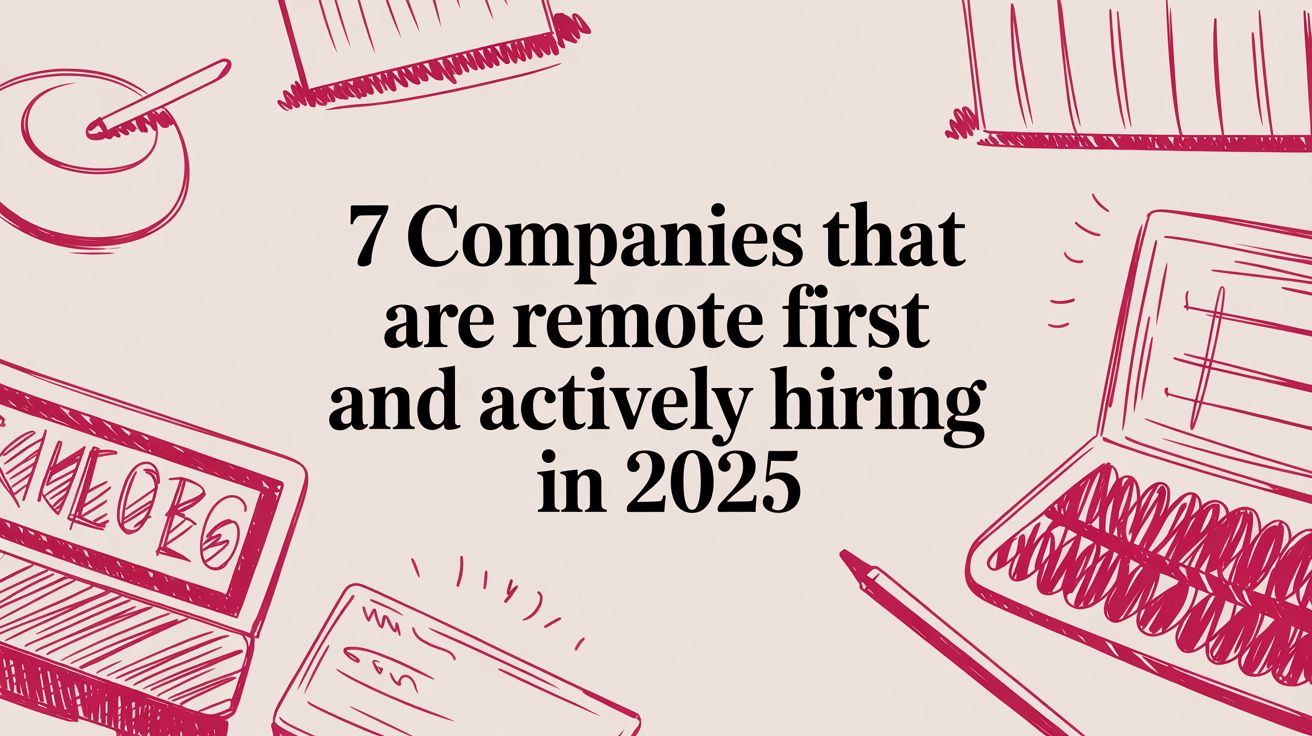7 Ways to Combat Remote Work Loneliness in 2025
Max
Feeling the Remote Work Blues?
Remote work offers flexibility, but it can also bring loneliness. Miss those office interactions? This listicle provides seven practical strategies to combat remote work loneliness and foster a more connected experience. Learn how virtual coffee breaks, co-working spaces, online communities, and other tactics can help you thrive while working remotely. These simple yet effective solutions can dramatically improve your work-life balance and overall well-being. Reclaim your connection and find remote job opportunities that prioritize community at Remote First Jobs [link to website].
1. Virtual Coffee Breaks and Social Hours
Combating remote work loneliness can be a significant challenge for both individuals and organizations. One effective strategy to address this growing issue is the implementation of virtual coffee breaks and social hours. These scheduled, informal video calls are designed to replicate the spontaneous social interactions that naturally occur in office environments, fostering a sense of connection and camaraderie among remote team members. Unlike traditional meetings, these sessions steer clear of work-related discussions, focusing purely on social connection, allowing remote workers to build personal relationships with colleagues and combat the isolation that can sometimes accompany remote work.

Virtual coffee breaks and social hours thrive on an informal, unstructured conversation format. They are typically scheduled regularly – daily, weekly, or bi-weekly – and involve small groups of 3-8 people for optimal interaction. The absence of a work agenda or formal objectives allows for genuine connection and fosters a more relaxed atmosphere. These virtual gatherings can take various forms, including coffee chats, virtual lunch breaks, and even happy hours, providing flexibility and catering to different preferences. Learn more about Virtual Coffee Breaks and Social Hours This focus on purely social interaction is key to combating remote work loneliness, offering a dedicated space for team members to connect on a personal level.
This approach deserves its place on any list addressing remote work loneliness because it directly targets the core issue: lack of social interaction. It provides a structured yet relaxed environment where remote workers can engage in casual conversations, share experiences, and build rapport, ultimately contributing to a stronger sense of belonging within the team. Companies like Zapier, known for their early adoption of structured virtual socialization, have successfully integrated daily coffee chat rooms into their remote work culture. Buffer, a company that has extensively documented their remote work practices, holds weekly team coffee breaks. GitLab utilizes a virtual coffee chat bot that randomly pairs employees, fostering connections across different teams and departments. Automattic, another prominent remote-first company, hosts weekly social hours across various time zones, acknowledging the global nature of their workforce. These examples demonstrate the versatility and adaptability of virtual social gatherings in diverse remote work settings.
Implementing virtual coffee breaks and social hours successfully requires careful consideration and planning. Keep sessions short and sweet, ideally between 15-30 minutes, respecting everyone’s time commitments. Rotating the timing of these sessions is crucial, especially for global teams, ensuring fair participation opportunities across different time zones. Using conversation starters or icebreaker questions can help overcome initial awkwardness and stimulate engaging discussions. While participation should be encouraged, it’s essential to keep it voluntary to avoid adding unnecessary pressure. Introducing themed sessions, such as book clubs or hobby discussions, can further enhance engagement and cater to specific interests.
While virtual coffee breaks and social hours offer numerous benefits, they also come with potential drawbacks. Initially, these sessions might feel forced or awkward, particularly for team members who are less comfortable with virtual interaction. Time zone differences can present a challenge for global teams, requiring careful scheduling and consideration. For some, these virtual gatherings may compete with personal time, highlighting the importance of maintaining a healthy work-life balance. Finally, consistent participation is crucial for these initiatives to be effective. Without regular engagement, the intended sense of community may not fully develop.
Despite these potential challenges, the benefits of virtual coffee breaks and social hours far outweigh the drawbacks. They effectively recreate office water cooler conversations, fostering personal connections and trust among team members. They are relatively low-time commitment and easy to implement, requiring minimal resources and planning. They contribute significantly to maintaining a positive and vibrant team culture, even in a remote setting. Most importantly, they effectively reduce feelings of isolation and loneliness, a common struggle for remote workers. By prioritizing social connection, organizations can cultivate a more engaged, productive, and fulfilled remote workforce.
2. Co-working Spaces and Remote Work Hubs
Combating remote work loneliness can be a significant challenge for those accustomed to the social buzz of a traditional office. One powerful solution lies in co-working spaces and remote work hubs. These dynamic environments offer a physical shared workspace where remote workers can work alongside others, fostering the social atmosphere and professional environment of a traditional office while maintaining the flexibility of remote work. They effectively bridge the gap between the potential isolation of working from home and the collaborative energy of an office setting, providing a valuable resource for those struggling with the social disconnect that remote work can sometimes bring. This approach is particularly valuable for individuals who thrive in social environments and find that their productivity and well-being are enhanced by being around others.

Co-working spaces operate on a membership basis, offering various options to suit different needs, from daily passes to monthly subscriptions. This flexibility allows remote workers to choose the level of engagement that works best for them, whether it’s a few days a week or a full-time dedicated desk. These spaces typically provide a range of professional amenities, including high-speed internet, meeting rooms, printing facilities, and often, a communal kitchen area. The design of co-working spaces is often geared towards fostering collaboration and networking, with open-plan layouts, designated networking areas, and regular community events and workshops. They provide a structured work routine and a reason to “commute,” which can be beneficial for those who struggle with self-discipline or find themselves blurring the lines between work and personal life when working from home.
Successful examples of co-working spaces include WeWork, a global network used by individuals and remote teams alike, and Selina, which caters specifically to the growing digital nomad community. Additionally, companies like Industrious and Regus offer more localized co-working solutions. Some companies, like Spotify and Dell, even sponsor co-working memberships for their remote employees, recognizing the value of these spaces in fostering connection and productivity.
The benefits of using co-working spaces to combat remote work loneliness are numerous. They provide immediate access to social interaction, combating feelings of isolation and fostering a sense of community. They offer a dedicated professional work environment away from home distractions, which can be particularly beneficial for those who struggle to maintain focus in a home setting. Co-working spaces also offer invaluable networking opportunities across various industries, enabling remote workers to expand their professional connections and potentially collaborate on new projects. Learn more about Co-working Spaces and Remote Work Hubs
However, it’s important to consider the potential drawbacks. Co-working spaces represent an additional cost beyond a home office setup, and the commute time and associated transportation costs can be a factor. They offer less flexibility than working entirely from home, and the shared environment can sometimes be subject to noise and distractions. Availability can also be limited in some areas.
To maximize the benefits of co-working, consider these tips: Try day passes before committing to a full membership to ensure the space is a good fit. Look for spaces with active community managers who organize events and workshops to foster networking and community building. Choose a location with convenient transport links to minimize commute time. Consider spaces that offer a balance of open collaborative areas and quiet zones for focused work. Finally, actively participate in community events and workshops to maximize networking opportunities and integrate into the co-working community. This can help mitigate the feelings of remote work loneliness and build a strong sense of belonging. This approach is especially beneficial for individuals new to remote work or a city, providing a ready-made social and professional network. Ultimately, co-working spaces offer a valuable tool for remote workers looking to combat loneliness, enhance productivity, and thrive in a flexible work environment.
3. Digital Nomad Communities
Combatting remote work loneliness can be challenging, especially if you’re constantly relocating. Digital nomad communities offer a powerful solution for those seeking connection and support in the location-independent lifestyle. These communities, both online and offline, bring together remote workers who travel the world while pursuing their careers. They provide a built-in social network, practical resources, and shared experiences for individuals navigating the unique challenges of working from anywhere. This makes them an invaluable resource for combating the isolation that can sometimes accompany remote work, particularly for those embracing a nomadic lifestyle.

Digital nomad communities operate through a combination of online platforms and in-person meetups. Online platforms, like forums and social media groups, facilitate connection and resource sharing across geographical boundaries. These platforms often include location guides, tips for remote work, and discussions about the challenges and rewards of the nomadic lifestyle. Offline meetups, organized in digital nomad hubs around the world, provide opportunities for face-to-face interaction, fostering stronger bonds and creating a sense of belonging.
The benefits of joining these communities are numerous. They provide access to a global network of like-minded individuals, offering practical advice for travel, remote work logistics, and navigating cultural differences. This network also acts as a built-in social circle in new locations, reducing the feelings of isolation that can arise when frequently moving. Moreover, these communities often facilitate professional networking across industries, creating opportunities for skill sharing, collaboration, and career advancement. Finally, the cultural exchange inherent in these communities fosters personal growth and expands worldviews. Successful examples include Nomad List (nomadlist.com), a massive community of over 50,000 members providing data-driven insights into various locations, and Remote Year, which offers organized travel programs for remote workers. Hacker Paradise organizes community trips for tech professionals, WiFi Tribe provides co-living and co-working experiences, and numerous local meetups thrive in digital nomad hubs like Lisbon, Bali, and Mexico City.
However, joining a digital nomad community isn’t without its considerations. This lifestyle requires significant changes, including the ability to work independently and adapt to new environments frequently. The cost of living can be high in popular nomad destinations, requiring careful budgeting. Time zone differences can also pose challenges for maintaining consistent work commitments. The transient nature of many nomad communities means relationships can be temporary, and the lifestyle isn’t suitable for everyone’s personal situation.
If you’re considering joining a digital nomad community to alleviate remote work loneliness, start by engaging with online communities before committing to travel. This allows you to gauge whether the lifestyle aligns with your personality and professional goals. When choosing destinations, prioritize nomad-friendly locations with reliable internet infrastructure and co-working spaces. Maintain open communication with your employer about your travel plans and ensure you budget adequately for potentially higher living costs in popular destinations. Once you arrive in a new location, actively participate in local meetups and co-working spaces to connect with fellow nomads.
Digital nomad communities deserve their place on this list because they directly address the social isolation many remote workers experience, especially those who are location-independent. They provide a structured approach to building a support network, finding practical resources, and fostering a sense of community while working and traveling the world. This targeted approach to combating remote work loneliness makes them an invaluable asset for those embracing the nomadic lifestyle. Key figures who have popularized this movement include Pieter Levels, founder of Nomad List; Greg Caplan, founder of Remote Year; Matt Mullenweg, CEO of Automattic and a prominent nomad advocate; and Tim Ferriss, author of “The 4-Hour Workweek,” which promotes lifestyle design and location independence. By understanding the features, benefits, and potential drawbacks, remote workers can make informed decisions about whether joining a digital nomad community is the right solution for combating loneliness and enriching their remote work experience.
4. Buddy Systems and Peer Support Networks
Combating remote work loneliness requires proactive strategies, and buddy systems and peer support networks are proving to be particularly effective. These structured programs pair or group remote workers together for regular check-ins, mutual support, and social interaction. This creates a sense of community and belonging, which is often missing in dispersed teams. By fostering both professional and personal connections, these systems ensure that no one feels isolated or falls through the cracks of remote work. This approach acknowledges that even the most introverted individuals can benefit from regular, low-pressure social contact within their work environment. Addressing remote work loneliness proactively boosts morale, improves communication, and ultimately increases productivity.

Buddy systems and peer support networks can take various forms, from one-on-one pairings to small groups. Regular scheduled check-ins, whether weekly or bi-weekly, are key to their success. These check-ins provide a dedicated time for colleagues to connect, share experiences, and offer mutual support. The interaction isn’t solely focused on work tasks; it encourages a blend of professional and personal connection, fostering genuine relationships. Structured onboarding for new remote employees is another vital component, ensuring they quickly integrate into the team and feel supported from day one. Learn more about Buddy Systems and Peer Support Networks for best practices regarding onboarding and creating a supportive remote environment.
Several companies have successfully implemented these systems. Shopify’s buddy system for new remote hires, for instance, provides each newcomer with a seasoned employee who guides them through the company culture and answers any questions. Trello’s peer mentorship program encourages knowledge sharing and skill development within their distributed teams. GitHub’s pairing system connects developers for collaborative coding and problem-solving, while HelpScout’s cross-department buddy assignments foster interdepartmental communication and collaboration. Toggl takes a dynamic approach with monthly buddy rotations, allowing employees to connect with a wider range of colleagues and expand their internal network.
The benefits of these programs are numerous. Guaranteed regular social contact combats isolation, and mutual accountability and support help remote workers stay on track and motivated. The informal nature of these connections also allows for early identification of potential issues, whether work-related or personal, before they escalate. Perhaps most importantly, these systems build strong individual relationships, creating a more cohesive and supportive work environment. This is particularly effective for new hires, helping them quickly integrate and feel like a valued part of the team.
While the advantages are significant, it’s important to acknowledge the potential drawbacks. Careful matching for compatibility is essential; if personalities don’t mesh, the system can feel forced and unproductive. The program also requires organizational support and structure to be successful, including dedicated time and resources. There’s also a risk of creating dependency rather than independence if the system isn’t managed carefully.
To maximize the effectiveness of buddy systems and peer support networks, consider the following tips: match people based on complementary skills and personalities, considering shared interests and work styles. Provide a basic structure for the check-ins but allow flexibility in the interaction style, letting the individuals determine how they want to connect. Encourage both work-related and personal check-ins to foster well-rounded relationships. Rotate partnerships periodically to expand networks and encourage interaction across different teams. Finally, consider training participants on effective peer support techniques, such as active listening and empathetic communication, to ensure they can provide meaningful support to one another.
Implementing these strategies can significantly reduce remote work loneliness and contribute to a more connected, supportive, and ultimately more productive remote work environment. By addressing this often-overlooked aspect of remote work, companies can attract and retain top talent, foster a strong company culture, and thrive in the increasingly distributed world of work.
5. Online Interest-Based Communities and Clubs
Combatting remote work loneliness often requires thinking outside the traditional office water cooler. One increasingly popular and effective solution lies in the vibrant world of online interest-based communities and clubs. These virtual gatherings, centered around shared hobbies, professional development goals, or even just a common interest in remote work itself, offer a powerful antidote to isolation and a way to forge genuine connections outside of work responsibilities. This approach is particularly effective in addressing remote work loneliness because it fosters a sense of belonging and shared identity, vital components often missing in a distributed work environment.
These communities operate on the principle of bringing people together based on shared passions rather than physical proximity. They leverage the power of digital platforms to facilitate communication and interaction, providing a space for remote workers to connect with like-minded individuals regardless of their geographical location. This is crucial in combating the isolation that can arise from working remotely, as it transcends the limitations of physical office spaces and allows for connection on a global scale. For those struggling with remote work loneliness, these communities offer a virtual “water cooler,” fostering casual interactions and a sense of camaraderie.
Online interest-based communities take on various forms. They can exist as Slack communities, such as the Remote Work Association (remoteworkassociation.com), which provides networking opportunities and resources for remote professionals. Discord servers cater to specific industries or niche interests, fostering in-depth discussions and collaborative projects. Facebook groups, like the numerous “Remote Work Community” groups, offer a more casual platform for sharing experiences and seeking advice. Professional associations with virtual chapters extend their networking and development opportunities to remote members. Even within companies, internal clubs focusing on activities like book clubs, fitness groups, or gaming communities can help remote employees build bonds and foster a stronger sense of belonging.
Features and Benefits:
Online interest-based communities generally offer a mix of synchronous and asynchronous interaction, catering to different schedules and preferences. Regular virtual meetings, workshops, or online events provide opportunities for real-time engagement, while forums, chat channels, and social media threads allow for ongoing discussions and connection. The shared interest or hobby acts as a natural conversation starter, removing the awkwardness that can sometimes accompany purely work-related interactions. Furthermore, many communities facilitate peer learning and skill development, offering workshops, webinars, and mentorship opportunities. This can be particularly valuable for remote workers seeking to expand their professional networks and enhance their skillsets.
Pros and Cons:
The benefits of joining these communities are numerous. They provide natural conversation topics and facilitate the building of relationships beyond the confines of work. They offer opportunities for learning and development and are accessible 24⁄7, accommodating individuals across different time zones. Perhaps most importantly, they can lead to deep, meaningful connections based on shared passions and values.
However, it’s crucial to be aware of the potential drawbacks. Participating actively in these communities requires a time investment outside of work hours, which may not be feasible for everyone. They may also not appeal to all personality types, particularly those who prefer more introverted activities. There’s a risk that a community can become another obligation rather than an enjoyable activity. Finally, the quality of these communities varies significantly, and it may take some experimentation to find the right fit.
Actionable Tips for Success:
To maximize the benefits and minimize the downsides, consider the following tips:
- Choose Wisely: Select communities aligned with your genuine interests. Passion is contagious, and joining a group centered around something you truly care about will make participation more enjoyable and sustainable.
- Active Participation: Don’t just lurk. Actively engage in discussions, share your insights, and contribute to the community. This is how you build connections and make your presence felt.
- Embrace Synchronous Interaction: Attend virtual events and video calls when possible. These real-time interactions can foster a stronger sense of connection than purely text-based communication.
- Give Back: Share your knowledge and help others within the community. Reciprocity is key to building strong relationships.
- Set Boundaries: Avoid community overload. It’s easy to get sucked into multiple online communities, but it’s important to set boundaries to prevent burnout and ensure you’re prioritizing your well-being.
Online interest-based communities offer a powerful solution to the pervasive challenge of remote work loneliness. By connecting individuals based on shared passions and providing a platform for meaningful interaction, they help remote workers cultivate a sense of belonging, combat isolation, and build genuine connections that extend far beyond the digital workplace. This makes them a valuable resource for anyone navigating the unique challenges of remote work.
6. Structured Team Building and Social Activities
Combating remote work loneliness requires a proactive approach, and structured team-building and social activities are crucial tools in that arsenal. These aren’t your typical work meetings; they’re specifically designed virtual events focused on fostering camaraderie, building connections, and creating a sense of belonging among remote team members. By going beyond project discussions and delving into shared experiences, these activities can significantly alleviate feelings of isolation and strengthen interpersonal relationships, thus directly addressing a key contributor to remote work loneliness. This is why structured team building deserves a prominent place on this list – it offers a dedicated space for social interaction and connection, a critical need for remote workers.
Structured team-building activities operate on the principle of planned engagement. They have clear objectives, moving beyond simple socializing to aim for specific outcomes like improved communication, stronger team cohesion, or increased cross-departmental understanding. The structure itself provides a framework for interaction, making it easier for remote workers, particularly those who are new to the team or more introverted, to participate and connect. This structured approach helps combat the ambiguity and isolation that can sometimes characterize remote work, providing a predictable and engaging avenue for social connection.
A key feature of effective virtual team building is variety. This could take the form of online games like virtual escape rooms and murder mystery games, where teams work together to solve puzzles and achieve a common goal. Other options include online cooking classes or wine tastings, remote team trivia competitions, virtual book clubs or documentary viewing parties, and online gaming tournaments or puzzle challenges. This variety caters to different interests and personality types, ensuring broader team engagement and preventing the activities from becoming stale or predictable. Learn more about Structured Team Building and Social Activities
For example, a fully remote software development company experiencing communication issues due to siloed working could implement weekly virtual coffee breaks, rotating hosts each week. Another company might organize a monthly virtual “lunch and learn” session combined with a casual online game, fostering both professional development and social connection. These structured activities, planned with intention and tailored to the team’s needs, can bridge the distance gap and create a more connected and engaged remote workforce.
The benefits of structured team-building activities are numerous. They deliberately cultivate team relationships, fostering a sense of community and shared identity. The shared experiences and memories created during these activities provide conversational fodder and strengthen bonds, ultimately contributing to a more positive and collaborative work environment. They also provide structure for social interaction, which can be particularly helpful for new team members struggling to integrate into a remote setting.
However, it’s important to acknowledge the potential downsides. Some team members, particularly introverts, may find these activities feel forced or artificial. Organizing these events requires time and resources, and there’s always the risk of them becoming repetitive or boring if not carefully planned and executed. Scheduling can also be a challenge, especially with teams spread across multiple time zones.
To ensure success, consider the following tips: Survey team preferences before planning activities to gauge interest and ensure buy-in. Rotate activity types to appeal to a wider range of interests and prevent boredom. Keep sessions optional but encourage participation, respecting individual comfort levels while fostering a culture of connection. Provide clear instructions and technical support to minimize frustration and ensure smooth participation. Finally, follow up activities with opportunities to discuss the experience, fostering continued engagement and strengthening the bonds created during the event.
Popularized by team-building companies like TeamBuilding.com and virtual event platforms like Remo and Airmeet, structured team-building activities are gaining traction as a key strategy for combating remote work loneliness. HR leaders and industry experts are also increasingly sharing best practices on platforms like LinkedIn and industry blogs, contributing to the growing understanding of the importance of intentional social interaction in the remote workplace. Addressing remote work loneliness proactively is vital for maintaining employee well-being and productivity, and structured team-building activities offer a powerful and effective way to achieve that.
7. Mental Health Support and Wellness Programs
Remote work offers incredible flexibility and autonomy, but it can also lead to feelings of isolation and loneliness. Combating this requires a proactive approach, and that’s where robust mental health support and wellness programs come into play. These programs are crucial for addressing the psychological challenges of remote work, specifically targeting loneliness as a legitimate workplace wellness concern. They go beyond simply acknowledging the problem; they provide tangible resources and support to help employees thrive in a remote environment. This approach is becoming increasingly important in combating remote work loneliness and deserves a prominent place on this list because it directly addresses the root causes of the issue, rather than just treating the symptoms.
These programs typically encompass a range of features designed to support employee wellbeing. Employee Assistance Programs (EAPs) offer confidential counseling and support services. Mental health days and flexible time off policies allow employees to prioritize their mental wellbeing without fear of repercussions. Wellness stipends and resources can cover gym memberships, mindfulness apps, or even therapy sessions. Crucially, mental health training for managers empowers them to recognize signs of isolation or distress in their team members and intervene appropriately. Anonymous support channels and resources further ensure that employees feel comfortable seeking help without fear of judgment.
Several companies are leading the way in implementing successful mental health and wellness initiatives. Headspace for Work, for example, provides guided meditation and mindfulness programs specifically tailored for the workplace. BetterHelp has forged corporate partnerships to offer convenient and affordable access to therapy for employees. Lyra Health offers a comprehensive mental health platform connecting individuals with therapists, coaches, and self-guided resources. Spring Health takes a personalized approach, using data and technology to match employees with the most appropriate mental health support. Many companies also offer wellness stipends that can be used for mental health apps or other wellness resources.
For companies looking to implement or enhance their mental health programs, several actionable tips can ensure effectiveness. Firstly, offer a variety of resources to cater to diverse needs. Not everyone will resonate with meditation, while others might prefer one-on-one therapy. Learn more about Mental Health Support and Wellness Programs. Training managers to recognize signs of isolation and distress is vital for early intervention. Providing stipends specifically for therapy or counseling removes financial barriers to accessing professional help. Creating a culture of psychological safety is paramount, ensuring employees feel comfortable seeking help without fear of stigma. Finally, regular check-ins focused on wellbeing, not just work performance, demonstrate a genuine commitment to employee mental health.
While these programs offer significant benefits, they are not without their challenges. Implementing comprehensive programs requires a significant company investment. There may be limited uptake due to lingering stigma around mental health. One-size-fits-all approaches may not effectively address individual needs. Privacy concerns related to mental health data must be carefully addressed. And perhaps most importantly, these programs require ongoing commitment and evaluation to ensure their effectiveness.
The pros of implementing these programs, however, far outweigh the cons. Addressing the root causes of remote work challenges leads to a healthier and more productive workforce. Providing professional support and resources equips employees with the tools they need to manage their mental wellbeing. These initiatives help reduce the stigma around mental health, creating a more open and supportive work environment. Ultimately, prioritizing mental wellbeing improves overall employee satisfaction, engagement, and retention, and can significantly reduce burnout and turnover.
When and why should companies use this approach? The answer is simple: proactively. Don’t wait for burnout or disengagement to become widespread. Prioritizing mental health from the outset is a crucial investment in the long-term success of any remote team. For remote job seekers, recruiters, HR professionals, companies transitioning to remote work, tech and digital professionals, global talent agencies – in short, anyone involved in the remote work landscape – understanding and advocating for robust mental health support is essential. Addressing remote work loneliness is not just about offering perks; it’s about creating a sustainable and supportive work environment where everyone can thrive. These programs are not just a “nice-to-have”; they are a necessary component of a healthy and productive remote work culture.
7 Strategies for Combating Remote Work Loneliness
| Strategy | Implementation Complexity 🔄 | Resource Requirements ⚡ | Expected Outcomes 📊 | Ideal Use Cases 💡 | Key Advantages ⭐ |
|---|---|---|---|---|---|
| Virtual Coffee Breaks and Social Hours | Low - easy scheduling and setup | Minimal - video tools and time | Improved social connection, reduced isolation | Small remote teams aiming to boost casual bonds | Builds trust and culture with low time commitment |
| Co-working Spaces and Remote Work Hubs | Medium - requires location setup | High - membership and commute | Enhanced focus, professional environment, networking | Remote workers needing office-like setting | Immediate social interaction and professional space |
| Digital Nomad Communities | Medium - ongoing community mgmt | Moderate - platform and events | Broad networking, cultural enrichment, travel support | Location-independent workers and travelers | Access to global peers and practical travel advice |
| Buddy Systems and Peer Support Networks | Medium - structured pairing | Moderate - management oversight | Regular social contact, accountability, early issue detection | Onboarding new remote employees, team support | Strong individual connections and mutual support |
| Online Interest-Based Communities & Clubs | Low - virtual platform use | Low to Moderate - platform and moderation | Deeper social bonds via shared interests, skill growth | Remote workers wanting non-work socialization | Builds meaningful relationships beyond work |
| Structured Team Building and Social Activities | Medium to High - planning and execution | Moderate - facilitation and tools | Enhanced team cohesion, collaboration, engagement | Remote teams needing deliberate relationship building | Creates shared experiences and team integration |
| Mental Health Support and Wellness Programs | High - comprehensive program | High - professional services and resources | Improved wellbeing, reduced burnout, stigma reduction | Organizations prioritizing employee mental health | Addresses root causes with professional support |
Ready to Reconnect?
Remote work loneliness is a real challenge, but it’s not insurmountable. As we’ve explored, fostering connection in a remote work environment requires a multi-faceted approach. From virtual coffee breaks and co-working spaces to online communities and robust wellness programs, the strategies outlined in this article provide a solid foundation for combating isolation and building a thriving remote work experience. The key takeaway is that proactive engagement—both individually and organizationally—is crucial. Looking for more ways to connect with your remote team and combat loneliness? Explore these engaging remote team building activities. These activities can help to build camaraderie and strengthen team bonds, which helps combat loneliness.
Mastering these approaches is valuable not just for individual wellbeing but also for overall team performance and company success. A connected team is a more engaged, productive, and innovative team. By prioritizing connection, we create a work culture where everyone feels supported, valued, and empowered to thrive, regardless of location. Remember, combating remote work loneliness isn’t just about fixing a problem—it’s about building a better future of work.
Ready to prioritize your wellbeing and find a remote role that values connection? Explore opportunities on Remote First Jobs, a platform dedicated to connecting professionals with companies that prioritize employee wellbeing and offer resources to combat remote work loneliness. Start your search for a fulfilling and connected remote career today.


